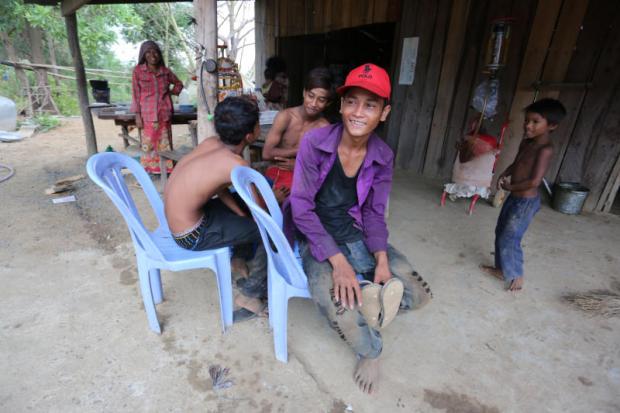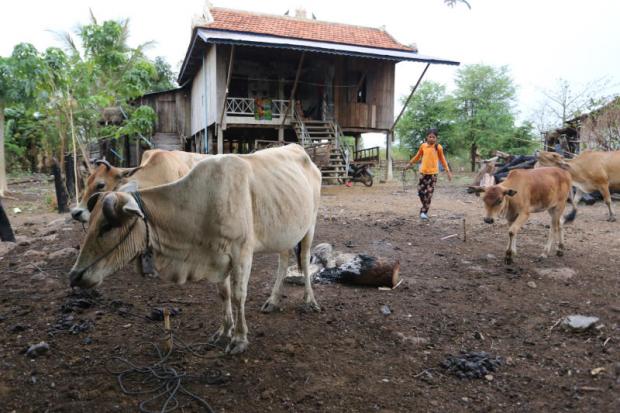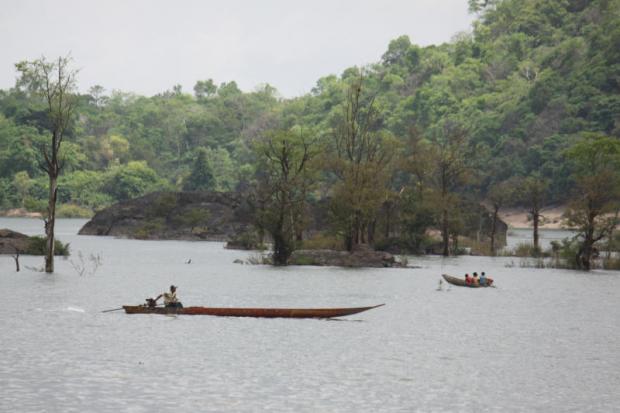
The cityscape of Phnom Penh resembles a work in progress. On a strip of land marking the cross-section of the Mekong and Tonle Sap rivers, a new hotel under construction and empty plots face the centuries-old Royal Palace.
Nowadays, restaurants and nightclubs come packed with tourists in the capital city. Around them, signs of construction abound, with steel bars and cement blocks piled up on footpaths everywhere.
"Four years ago, it looked nothing like this," said Chenda, a hotel owner who goes by a fake name. We were standing on the rooftop restaurant of the five-storey hotel he runs, complete with a shiny terraced pool area.
"You see that?" he says, pointing to the sprawling commercial plots below. "It will be a real city soon."
A crop of modern buildings has sprung up in the past five years in Phnom Penh. The construction of roads, malls and high-rise residences has become a ubiquitous sight.
According to the Council for Development of Cambodia, China is the country's biggest source of foreign direct investment.
Despite a global economic slowdown, the country's gross domestic product has grown at a rapid average of 7% since 2011. The tourism market is growing rapidly too, with the number of tourist arrivals tripling between 2006 and last year.
This opening in the market gave Chenda the chance to reinvent his life, many years of which he spent under the Cambodian-Vietnamese War and the civil war.
Cambodia finally became peaceful in the late 1990s, but the unrest didn't end there.
Achieving economic growth under Prime Minister Hun Sen poses a new challenge for today's Cambodia. The contentious leader has played a large role in developing the electricity sector.
"Power is the most important sector. How can you run a bank or a company if you don't have electricity?" said Chenda. "Here, you'll never know when power will be cut off, even in a central area like where we're standing now."
The Minister of Industry, Mines and Energy (MIME) reported that only 22% of Cambodian households have access to electricity.
Power imported from neighbouring countries -- Vietnam, Thailand and Laos -- accounted for 25% of total supply in 2015, decreasing from 61% in 2010.
This figure is the outcome of Cambodia's mass power plant building project, which has focused on hydropower dams, holding a 43% share of domestic generation.
Since 2011, eight dams have been built across the country. Six involve management or funding by Chinese companies.
The current energy supply won't be sufficient to keep up with a growing demand. MIME projects that electricity demand will rise to a growth rate of 18.3% per year.
Power consumption in the service sector has increased more rapidly than any other sector in Cambodia.
Some argue that the project's benefits are being spread unevenly. Phnom Penh, for example, takes up at least 80% of the country's overall electricity consumption.
Hydropower dams in remote villages mainly provide for the capital city. Civil society groups have reported a range of adverse effects from these developments, from community displacement to damage done to local livelihoods and the environment.
In the year leading up to the next general election and amid rampant crackdowns on anti-government activists, the people left in the dark are being rendered silent too.
POWER PLAY
Growth in the electricity sector has helped the ruling Cambodian People's Party (CPP) gain support.
In "Political Ecology of Chinese Large dams in Cambodia", a study published in the Switzerland-based Multidisciplinary Digital Publishing Institute journal last year, it was determined that the building of the Chinese-funded Kamchay Dam forged closer political ties between China and Cambodia.
The launching of the dam helped secure Cambodia as China's political ally, leading to such decisions as opting out of Asean's collective statement on the South China Sea conflict.
The Kamchay Dam is Cambodia's first hydropower dam and has been operating since 2011. The dam was built with US$600 million in aid from the United States alongside a trade and investment package from China's ExIm Bank.
The study found that the majority of electricity generated in the country provided for Phnom Penh, while many houses neighbouring the dam did not have any access to electricity.
During Chinese President Xi Jinping's visit to Cambodia last year, he pledged $600 million in aid to Cambodia over the next three years. The country's economy is majorly benefiting from China's investment capital, worth $864 million and $4.4 billion from bilateral trade in 2015.
The figures make Cambodia's economic future look bright. But some say the political consequences are problematic, lending more credibility to the CPP, who won the general election in 2013 amid accusations of election fraud.
As Cambodia braces itself for a general election next year and local elections this June, the crackdowns on activists and opposition figures have intensified, inciting accusations of the violation of human rights and freedom of expression.
In May last year, the Black Monday movement launched an anti-government protest after authorities arrested four members of the human rights group Adhoc and an election official for allegedly bribing a woman to stay silent on a sex scandal case involving Kem Sokha, the deputy leader of the opposition Cambodian National Rescue Party (CNRP).
Meanwhile, CNRP leader Sam Rainsy has been targeted by the CPP on a series of criminal charges. The accusations made Rainsy go into self-imposed exile in France.
Hun Sen recently revealed that he would have the court seize Rainsy's property in Cambodia, one of several examples of the state ordering the court to punish opposition figures.
In another case, environmental activists Try Sovikea, Sun Mala and Sim Samnang from the NGO Mother Nature were sentenced last year to 18 months imprisonment for threatening to destroy property while protesting sand dredging in Koh Kong province. They were released early after having served the sufficient time in their pretrial detention, according to Amnesty International.
Environmental activists are regularly threatened in Cambodia.
Speaking at the 2015 inauguration of the 246-megawatt hydropower Steung Tatay Dam in Koh Kong province, Hun Sen threatened to cut off electricity from the households of any environmental activists who protested about the government's dam projects.
He referred to them as "environmental extremists who oppose everything".
"Dams represent the control of political power," said Tek Vannara, executive director of the NGO Forum on Cambodia. "But maybe economic development will change in the next 10 years so that we may not need to build mega dams like today."
Open Development Cambodia, an online data hub, indicates that 65 hydropower dams are connected to Cambodian pipelines. At least seven have been developed by Chinese companies.
CHANGING TIDES
A crumbling statue of a smiley Irrawaddy dolphin in Stung Treng province's Preah Romkil village faces the Mekong River at the Cambodia-Laos border.
Looking over at Lao territory, just two kilometres from Cambodia's river bank, the construction work surrounding the 260-megawatt Don Sahong Dam is visible.
Don Sahong is the second mainstream dam built on Laos' slice of the Mekong. Its construction was launched in 2015 following the building of the controversial Xayaburi Dam, which some speculated was built without impact assessments.
A school of Irrawaddy dolphins swims through the water, their fins bobbing up and down. Tourist boats float by on their dolphin watching adventures.
"Villagers here benefit from the dolphin tours," said Lok Chanthou, 50, a core leader of the Preah Romkil community. "We run a community-based ecotourist project for dolphin watching and the business helps us survive."
In 2007, the villagers formed a dolphin watching tour committee. Tourists mostly come from Laos or neighbouring countries.
However, the dam construction currently under way could jeopardise their business by disrupting the dolphins' habitats. Locals are concerned it will drain the area of its tourist appeal.
It's expected that the Don Sahong Dam, developed by the Malaysia-based Mega First Corporation Berhad and the government of Laos, will generate electricity to be sold to Cambodia and Thailand.
The project has been in the works since 2006. American NGO International River reported that China's Sinohydro International Co-operation, which also built Kamchay Dam, was contracted to construct the project.
The project was criticised for failing to engage with locals' concerns and the lack of trans-boundary impact assessments done, despite the Lao government's insistence that it has.
Last year the Phnom Penh Post reported that Prime Minister Hun Sen made a Facebook post stating: "After Cambodia inspected the situation, it does not have a problem with the dam development project."
He thanked Laos for its pledge to sell low-cost electricity to Cambodian provinces nearby the dam.
Critics say China's involvement in the dam's construction could be influencing Hun Sen's treatment of the issue.
Some speculate that the Don Sahong Dam project could inflict major trans-boundary effects, including a change in water flow that could damage ecology and fish habitats. According to the World Wildlife Fund, the Mekong River's Irrawaddy dolphins are close to extinction. It's estimated that around only 78 to 91 remain in the river in various parts of Cambodia and Laos.
"The dam will benefit other cities," said Lok, the community leader. "For communities living close to the dam, we are victims of the project."
THE ROAD AHEAD
For Yen Wut, a 55-year-old who experienced the brutality of the Khmer Rouge regime first hand, the idea of a booming Cambodian economy was previously unfathomable.
In 1979, he was evicted by force from Preah Romkil village after the Khmer Rouge moved into the area. He witnessed people being tied and beaten. Only 100 metres away from his home, he heard about women being raped at a militants' camp.
In 1991, when peace began to be restored, Yen Wut moved back to his village and resumed his livelihood working in the rice fields. Occasionally, he did trade with Lao people.
As the market gradually shifted towards tourism, he too changed his agricultural practice. Now he works for a local tourism committee.
"After the war, our life was incredibly challenging because of the change in soil [left degraded by the fighting, land mines and deforestation]. I couldn't imagine my country building itself back up again," he said.
"But the picture is so different today. I never expected that I would have the career I have now."
However, the Don Sahong Dam could pose a threat to his success.
Meanwhile, the government is building Lower Se San 2 Dam on the Mekong tributary called Se San River, located 35km downstream from Yen Wut's village.
The project is a joint venture between the Royal Group of Cambodia and China's HydroLancang International Energy.
His village doesn't have electricity yet.
While travelling from Phnom Penh to Preah Romkil, we stopped at several small communities which didn't have any electricity. Some families depended on a small solar panel. Several local farmers told us they earned around two to five US dollars per day.
A Phnom Penh office worker told me that his office paid a steep $120 per month for a freezer and three air conditioners that were not even in regular use.
The city faces occasional blackouts. These are particularly bad during the dry season when power consumption is at its peak.
"We rely on our neighbours a lot. Maybe the reason why the government is building all these dams is because the country has to learn to sustain itself," said Chenda.
"From my point of view, I think there are two sides of the coin. We have to plan our development carefully. People need energy. But at the same time hydropower dams can have environmental and social costs."
Three days after I met Chenda, his wife sent me a message requesting I use a fake name for him in my article. She said she was concerned about him, an established businessman, being targeted for criticising Hun Sen's government.
As we sit on the rooftop that day, he told me a dream of his.
"I want to see everywhere in Cambodia look just like Norodom Boulevard. It's a main road with beautiful trees, a beautiful walkway -- a beautiful road. I want to see all the roads look like that. We must all aspire to this dream."

boom time: Construction sites are a common sight in Phnom Penh, home to a crop of new malls and high-rise residences. The economy is benefiting from vast sums of foreign direct investment from China.

power hungry: A restaurant in Phnom Penh, said to consume the majority of Cambodia's electricity. PHOTOS: Paritta Wangkiat

local life: Villagers in Kratie province hang out in front of a shop. PHOTOs: Paritta Wangkiat

after the war: The civil war and Cambodia-Vietnam War left the country in a fragile state politically and environmentally. Environmental challenges included degraded soil, deforestation and land mines.

swim of things: Dolphin-watching tour boat operators in Romkil village, Stung Treng province.

power out: A village in Kratie province, a two-hour drive from Don Sahong Dam, with no electricity.

small fish, big pond: The Mekong River at the Cambodian-Lao border, a short drive from the Don Sahong Dam built on Laos' part of the Mekong.